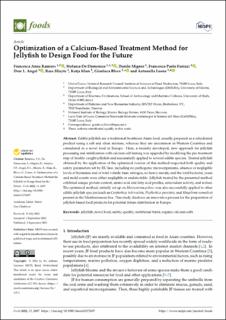Optimization of a Calcium-Based Treatment Method for Jellyfish to Design Food for the Future
Ramires, Francesca Anna; De Domenico, Stefania; Migoni, Danilo; Fanizzi, Francesco Paolo; Angel, Dror L.; Slizyte, Rasa; Klun, Katja; Bleve, Gianluca; Leone, Antonella
Peer reviewed, Journal article
Published version
Permanent lenke
https://hdl.handle.net/11250/3042989Utgivelsesdato
2022Metadata
Vis full innførselSamlinger
- Publikasjoner fra CRIStin - SINTEF Ocean [1369]
- SINTEF Ocean [1443]
Sammendrag
Edible jellyfish are a traditional Southeast Asian food, usually prepared as a rehydrated product using a salt and alum mixture, whereas they are uncommon in Western Countries and considered as a novel food in Europe. Here, a recently developed, new approach for jellyfish processing and stabilization with calcium salt brining was upgraded by modifying the pre-treatment step of freshly caught jellyfish and successfully applied to several edible species. Treated jellyfish obtained by the application of the optimized version of this method respected both quality and safety parameters set by EU law, including no pathogenic microorganisms, absence or negligible levels of histamine and of total volatile basic nitrogen, no heavy metals; and the total bacterial, yeast, and mold counts were either negligible or undetectable. Jellyfish treated by the presented method exhibited unique protein content, amino acid and fatty acid profiles, antioxidant activity, and texture. The optimized method, initially set up on Rhiszostoma pulmo, was also successfully applied to other edible jellyfish species (such as Cotylorhiza tuberculata, Phyllorhiza punctata, and Rhopilema nomadica) present in the Mediterranean Sea. This study discloses an innovative process for the preparation of jellyfish-based food products for potential future distribution in Europe.

